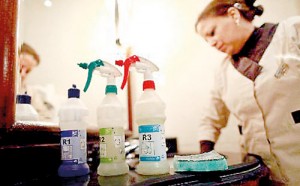Sunday Times 2
How cleaning with bleach can make children ill
Many parents are liberal with bleach, in the hope it will blast away illness-causing bacteria and leave the house sparkling.
But while it does indeed kill germs, the chemical could leave children more susceptible to catching flu, tonsillitis or other infections, a study suggests.

Cleaning a house weekly with bleach was linked with a 20 per cent increase in childhood infections (AFP)
Researchers found a link between a weekly use of bleach in the home and the frequency of infections, particularly respiratory ones.
They concluded that passive exposure to bleach was associated with a 20 per cent increase in the risk of flu in the previous year.
It was also linked with a 35 per cent rise in the risk of recurrent tonsillitis.
In light of the findings, experts said the use of bleach in the home was a ‘public health concern.’
The study took into account factors such as passive smoking at home, parental education, household mould and use of bleach to clean schools.
The findings indicated that the number and frequency of infections were higher among children whose parents regularly used bleach to clean the home in all three countries.
As well as being statistically significant for flu and tonsillitis, the risk of any recurrent infection was 18 per cent higher among children whose parents regularly used bleach.
One possible explanation was that the irritant properties of compounds generated during the cleaning process may damage the lining of lung cells, sparking inflammation and making it easier for infections to take hold.
Dr Lidia Casas, of the Centre for Environment and Health in Belgium, who carried out the research, said the study’s findings were concerning.
She said: ‘The high frequency of use of disinfecting cleaning products, caused by the erroneous belief, reinforced by advertising, that our homes should be free of microbes, makes the modest effects reported in our study of public health concern.
‘Passive exposure to cleaning bleach in the home may have adverse effects on school-age children’s health by increasing the risk of respiratory and other infections.
‘The high frequency of use of disinfecting irritant cleaning products may be of public health concern, also when exposure occurs during childhood.
She added: ‘Our findings back other studies indicating a link between cleaning products and respiratory symptoms and inflammation.
‘Bleach may also potentially suppress the immune system.’
The study emphasised that it was only observational, so no definitive conclusions can be drawn about cause and effect.
In addition they didn’t have any information on the use of other cleaning products used in the home, and only basic information was gathered on the use of bleach in the home, making it difficult to differentiate between exposure levels.
Dr Casas added: ‘Although modest, the results are of public health concern in light of the widespread use of bleach in the home, but we need more detailed studies in this area.’
The study was published online in Occupational & Environmental Medicine.
© Daily Mail, London

